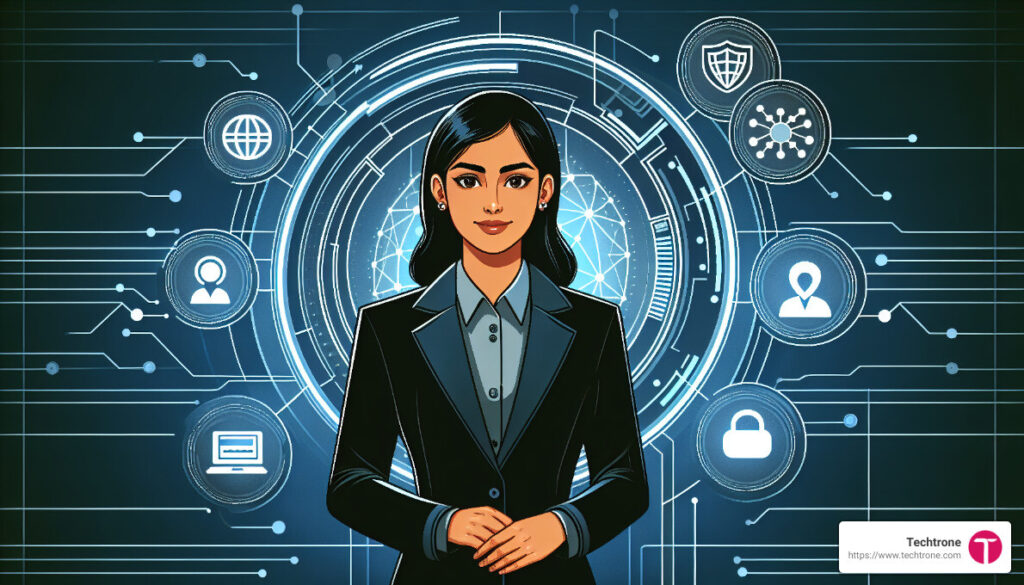If you’re exploring options for IT security solutions, it’s crucial to understand why these are essential for protecting your business from cyber threats. Effective IT security solutions safeguard your data, maintain customer trust, and ensure the smooth operation of your digital infrastructure. With cyber threats continually evolving, choosing the right security measures is more important than ever.
Overview, Importance, Current Trends
In the digital world, the importance of robust IT security solutions cannot be overstated. Businesses of all sizes face increasing threats from hackers and cybercriminals, and the consequences of a security breach can be devastating. This includes lost data, financial loss, and damage to reputation. For small to medium-sized enterprise owners, it is not just about having security measures in place; it’s about ensuring these measures are efficient, scalable, and cost-effective.
Currently, the IT security landscape is marked by a shift towards more integrated solutions like Extended Detection and Response (XDR) and proactive tools like Security Information and Event Management (SIEM). Businesses are investing more in cybersecurity, reflecting its growing priority in IT budgets globally. The integration of AI and machine learning has also become a trend, enabling more sophisticated detection capabilities and faster responses to security incidents.

Understanding these trends and the fundamental importance of IT security will guide you in making informed decisions that fit your specific business needs and help protect against current and future cyber threats.
Understanding IT Security Solutions
What is IT Security?
IT security is all about keeping your digital assets safe. It’s the armor that protects your business data from cyber threats like hackers, viruses, and data breaches. The goal is simple: prevent harm, protect assets, detect threats, and respond to incidents.
Types of IT Security
Network Security
This is your first line of defense. Network security manages access to your network and data, blocking unauthorized or harmful traffic. It’s like having a strong fence around your digital house.
Application Security
Think of application security as checking everything that goes in and out of your applications. It makes sure that the apps you use are not vulnerable to attacks, keeping your data safe when you’re using them.
Endpoint Security
Every device that connects to your network is an endpoint. Endpoint security focuses on making sure these devices do not become gateways for bad actors. Whether it’s your computer, smartphone, or tablet, endpoint security keeps them secured.
Data Security
The heart of IT security is protecting the data itself. Data security involves techniques like encryption and key management to keep your data safe whether it’s sitting unused (at rest) or being sent across the internet (in transit).
The Importance of IT Security
IT security isn’t just a nice-to-have; it’s essential. Businesses of all sizes face risks from cyber threats. Without strong IT security, you risk losing important data, money, and even your business reputation. Plus, with regulations like GDPR and CCPA, failing to secure data can also lead to hefty fines.
Components of IT Security
Prevention
Preventive measures are tools and policies you set up to stop attacks before they happen. This could be anything from installing antivirus software to training your employees on security best practices.
Protection
Protective measures are about limiting the damage if an attack happens. This includes firewalls that block unauthorized access and data encryption that keeps data safe even if it’s stolen.
Detection
Detection is all about spotting threats quickly. This could be through monitoring network traffic or using intrusion detection systems that alert you to suspicious activity.
Response
Finally, response measures are what you do after detecting a threat. This involves actions like isolating infected systems and conducting a thorough investigation to understand and mitigate the damage.
By understanding these key aspects of IT security, you can better prepare and protect your business from the evolving landscape of cyber threats. We’ll explore how to choose and implement the right IT security solutions for your specific needs.
Key Components of Effective IT Security Solutions
In the realm of IT security, understanding the foundational components is crucial for building a robust defense against cyber threats. Here, we discuss the strategies, technologies, and practices that form the backbone of effective IT security solutions.
The Four Pillars of IT Security
Prevention:
The first step in a strong IT security strategy is prevention. It involves deploying technologies and practices that help prevent unauthorized access or damage to systems. Tools like firewalls and antivirus software, and practices such as regular security audits and strict access controls, play a vital role here.
Protection:
Protection measures are designed to safeguard critical information and IT assets. This includes technologies such as data encryption and secure access protocols to ensure that data, whether at rest or in transit, remains inaccessible to unauthorized users.
Detection:
Detection technologies are crucial for identifying potential security breaches before they cause significant harm. Solutions like intrusion detection systems (IDS) and continuous monitoring tools help in recognizing suspicious activities that might indicate a cyber attack.
Response:
Effective IT security requires a planned response to security incidents. This involves procedures and tools for quickly addressing and mitigating threats, such as automated security incident response systems and crisis management teams.
The Seven Types of Cyber Security
Application Security:
Securing applications from threats involves measures like regular updates, security testing, and the implementation of application firewalls. This helps in defending against vulnerabilities that attackers might exploit.
Cloud Security:
With the increasing adoption of cloud services, protecting cloud-based systems is essential. Tools such as Cloud Access Security Brokers (CASB) and Cloud Workload Protection Platforms (CWPP) provide security management across various cloud services.
Critical Infrastructure Security:
This type of security focuses on protecting the systems and networks crucial for the functioning of vital societal functions. It involves robust security measures, including physical and IT security solutions, to guard against significant disruptions.
Data Security:
Protecting data involves encryption, secure storage solutions, and strict access controls to prevent unauthorized access to sensitive information. Data Loss Prevention (DLP) systems ensure that critical data does not leave the network without authorization.
Endpoint Security:
Endpoint security solutions protect devices like computers, mobile phones, and tablets from threats. Tools such as Endpoint Protection Platforms (EPP) and Endpoint Detection and Remediation (EDR) are used to prevent, detect, and respond to threats at the device level.
IoT Security:
As IoT devices proliferate, securing these devices becomes critical. This includes the implementation of security measures to protect IoT devices and the networks they connect to from manipulation and intrusion.
Mobile Security:
Mobile security solutions protect personal and corporate information stored on mobile devices. It includes mobile-specific solutions like mobile application management (MAM) and mobile device management (MDM) to control and secure mobile platforms.
Network Security:
This protects the usability and integrity of your network and data. It includes both hardware and software technologies, effective network security manages access to the network and targets a variety of threats to stop them from entering or spreading on your network.
By understanding and implementing these key components, businesses can build a comprehensive IT security strategy that not only protects against current threats but also adapts to the evolving landscape of cyber risks. As we delve deeper into the specifics of each type of security, it’s important to assess which solutions align best with your organizational needs and goals.
Top IT Security Solutions for Small Businesses
Small businesses often face unique challenges in the digital landscape, where limited budgets and resources can make comprehensive cybersecurity seem daunting. Yet, implementing robust IT security solutions is critical to protect sensitive data and maintain customer trust. Here, we explore top IT security solutions that are affordable, scalable, and efficient for small businesses.
Network Monitoring
Traffic Analysis and Real-time Monitoring
Network monitoring is essential for any small business to detect and respond to threats swiftly. This solution involves analyzing traffic to spot unusual activities that could indicate a breach or an attack. Real-time monitoring allows businesses to act quickly, potentially stopping attackers before they cause significant damage. Tools like SIEM solutions can aggregate and analyze network data, enhancing visibility and response capabilities.
Data Encryption Tools
At-rest and In-transit Protection
Data encryption is crucial to protect sensitive information both stored (at-rest) and sent (in-transit) across networks. Encryption tools ensure that even if data is intercepted, it cannot be read without the corresponding decryption key. Small businesses can implement encryption to safeguard customer data and comply with privacy regulations, contributing significantly to their security posture.
Intrusion Detection Systems (IDS)
Real-time Threat Detection and Automated Response
An IDS can monitor network traffic for suspicious activity and policy violations, providing real-time alerts. More sophisticated systems can automatically respond to detected threats, mitigating potential damage without the need for manual intervention. This capability is vital for small businesses that may not have the resources for a full-time security team.
Data Loss Prevention Systems (DLP)
Monitoring and Policy Enforcement
DLP systems help prevent data breaches by monitoring data usage and preventing unauthorized access or transmission. These systems can detect and block sensitive information from being shared inappropriately, such as through email or removable storage devices. For small businesses, DLP can enforce security policies automatically, simplifying data protection efforts.
Access Control Systems
Authentication and Authorization
Access control is fundamental to IT security, ensuring that only authorized users can access certain data or systems. Mechanisms like role-based access control (RBAC) and multi-factor authentication (MFA) can significantly enhance security by minimizing the risk of unauthorized access. Small businesses benefit from these systems as they provide a scalable method to manage user permissions efficiently.
Implementing these IT security solutions can help small businesses protect against cyber threats without requiring extensive resources. By focusing on systems that offer automation and real-time monitoring, small businesses can achieve a high level of security, ensuring they remain protected as they grow. Understanding how to integrate and manage these solutions effectively will be crucial for ongoing security and compliance.
Implementing IT Security Solutions in Your Business
Implementing IT security solutions in your business is a critical step towards safeguarding your digital assets and maintaining operational integrity. The process involves careful planning, strategic deployment, and diligent management. Here’s how to ensure you are effectively implementing the right solutions for your business.
Choosing the Right Solutions
Choosing the right IT security solutions starts with a thorough Needs Assessment. Identify what specific security threats your business faces and what assets you need to protect. This might include customer data, intellectual property, or financial information.
Solution Fit is about matching your specific needs with the right technology. For example, if your business handles a lot of sensitive customer data, encryption and data loss prevention systems should be on your list.
Vendor Selection is crucial. Look for vendors with a strong track record, robust customer support, and solutions that can scale with your business growth. SolarWinds, for instance, offers a range of IT security tools that help businesses make quicker security decisions with fewer resources, which is ideal for small to medium-sized enterprises.
Integration and Deployment
System Compatibility must be checked to ensure the new security solutions work with your existing IT infrastructure. Incompatible systems can lead to gaps in your security posture or require costly modifications.
Installation should be handled by professionals, either in-house IT staff trained for the task or external specialists provided by the vendor. Proper Configuration of the tools is essential to maximize their effectiveness and should be based on the specific threats and business processes they need to protect.
For example, continuous monitoring tools need to be fine-tuned to identify and alert on activities that are abnormal for your specific environment.
Ongoing Management and Updates
Once your IT security solutions are in place, Monitoring is continuous. This involves regular checks to ensure all systems are functioning as intended and that no new vulnerabilities have surfaced. Tools like SolarWinds can provide real-time alerting which helps in quickly identifying potential security incidents.
Updates are a critical aspect of security management. Cyber threats evolve rapidly, and your defenses need to keep pace. Ensure that your IT security solutions are set to update automatically or establish a regular schedule to manually update them.
Compliance is another ongoing requirement. Regular audits should be conducted to ensure that all IT security measures comply with relevant laws and regulations, such as GDPR or HIPAA, depending on your industry.
Implementing IT security solutions is not a set-and-forget process. It requires continuous assessment and adjustment to adapt to new threats and changes in the business environment. By following these guidelines, you can create a secure and resilient IT environment that supports your business objectives and protects your critical assets.
Frequently Asked Questions about IT Security Solutions
What are IT security solutions?
IT security solutions are tools and services designed to protect organizations from cyber threats. These solutions include software, hardware, and strategies that help prevent, detect, respond to, and recover from cyber attacks. The aim is to safeguard data, networks, and systems from unauthorized access, theft, or damage.
How do IT security solutions protect businesses?
IT security solutions protect businesses by:
- Blocking unauthorized access: Solutions like firewalls and access controls ensure that only authorized personnel can access sensitive information.
- Detecting threats in real time: Systems like intrusion detection and prevention systems monitor network traffic for suspicious activities, alerting security teams to potential threats.
- Encrypting data: Encryption tools secure data, making it unreadable to unauthorized users, whether it’s stored on systems or transmitted across networks.
- Ensuring recovery: Backup and recovery tools allow businesses to restore data quickly after a loss, whether due to technical failures, cyber attacks, or natural disasters.
These measures are crucial for maintaining the integrity and confidentiality of business data and ensuring that operations can continue smoothly in the face of cyber incidents.
What are the most critical types of IT security for small businesses?
For small businesses, the most critical types of IT security include:
- Antivirus and anti-malware software: This basic security measure is essential for protecting against malicious software that can steal, corrupt, or delete data.
- Firewalls: As a first line of defense, firewalls control incoming and outgoing network traffic based on predetermined security rules, offering protection against external threats.
- Data encryption: Protecting sensitive information, especially when transmitted over the internet, is crucial for maintaining privacy and compliance with regulations.
- Data backup solutions: Regularly backing up data ensures that a business can recover important information quickly and efficiently after data loss.
- Employee training: Educating staff on basic cybersecurity principles can significantly reduce the risk of breaches due to human error.
Implementing these security measures can help small businesses protect their resources from the most common and potentially devastating cyber threats.
Conclusion
In wrapping up our guide on choosing the right IT security solutions, we at Techtrone are committed to guiding you through the evolving landscape of cybersecurity. The digital world is rapidly changing, and with it, the nature of threats and the technologies designed to counter them are also advancing. Understanding these dynamics is crucial for continuous improvement and ensuring the security of your business.
Techtrone: Your Partner in Cybersecurity
At Techtrone, we don’t just provide solutions; we build partnerships that help small businesses thrive securely in their digital environments. Our approach combines cutting-edge technology with tailored services to meet the unique needs of your business. From initial assessments to the deployment and ongoing management of IT security systems, we ensure that you have the best defense mechanisms in place.
Future Trends in IT Security
Looking ahead, the future of IT security is poised to be shaped by several key trends:
- Artificial Intelligence and Machine Learning: These technologies will increasingly automate threat detection and response, reducing the time between threat identification and mitigation.
- Zero Trust Architecture: As businesses become more decentralized, the principle of ‘never trust, always verify’ will become fundamental in IT security strategies.
- Regulatory Compliance: With data protection regulations tightening globally, businesses will need to prioritize compliance through secure technologies and practices.
Understanding and adapting to these trends will be crucial for businesses looking to protect themselves against emerging threats.
Continuous Improvement: A Core Philosophy
At Techtrone, we believe in the power of continuous improvement. The cybersecurity landscape does not stand still, and neither do we. Our team is dedicated to staying ahead of the curve, leveraging the latest insights, and technologies to refine our offerings. This proactive approach not only enhances our services but also empowers your business to stay one step ahead of potential security risks.
We encourage our clients to view IT security not as a one-time setup but as an ongoing journey of enhancement and adaptation. To support this, we offer regular updates, training sessions, and support to ensure that your security systems evolve in line with the latest threats and technologies.
Discover more about how we can support your technology needs by visiting our Cybersecurity services page. Let us help you navigate the complexities of IT security with solutions that are not only robust but also scalable and cost-effective. Together, we can ensure that your IT infrastructure is not just secure but also a strategic asset for your success.
Thank you for joining us on this journey through the essentials of IT security solutions. With Techtrone as your trusted partner, you can face the future of cybersecurity with confidence.



